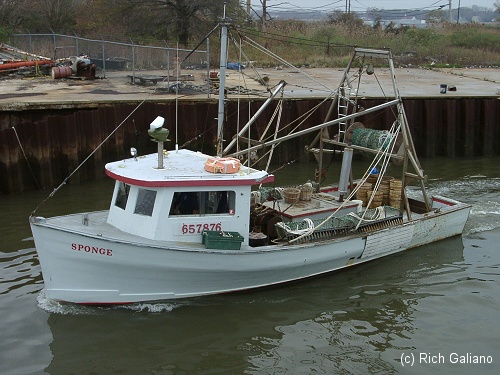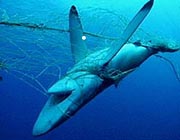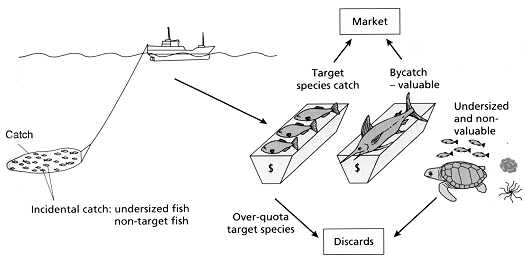Fishing Vessels

There are three basic types of commercial fishing vessels found in the Mid-Atlantic region: trawlers, seiners/gill-netters, and long-liners. A trawler or "dragger" operates by towing its fishing gear across the bottom. Weighted nets take bottom fishes, while cage-like steel dredges take clams and scallops. A seiner uses a floating net to encircle schools of surface-swimming fishes such as herring and tuna. A long-liner sets out miles of buoyed line with baited hooks to catch sharks, tuna, and swordfish. One could also add lobster boats and charter fishing or "head" boats to this list. And of course, dive boats.
One thing that all commercial fishing vessels have in common is that they have gotten too big and too good at what they do. Almost any species that is targeted can be overexploited in just a few seasons, and this has happened repeatedly over the years. When the fishermen exhaust one fishery, such as Cod, they simply switch to another, decimating one species after another. Only recently have government regulations, quotas, and oversight begun to stem this destruction. Estimates are that as much as 90% of the large fishes in all the world's oceans have been fished out.

Another major problem with most types of commercial fishing is bycatch. Bycatch is the term for everything else that is caught that was not targeted. Bycatch can be anything from fish to dolphins to turtles - most commercial fishing methods are as indiscriminate as they are efficient. Some bycatches are desirable, but most are simply discarded as trash, resulting in the destruction of many species which are not even economically important. Fisheries are regulated to minimize bycatch, but since it is inevitable, a certain amount of bycatch is expected and allowed for.

Fishermen face much the same set of problems as farmers. With no control over market price, all they can do is catch and sell as much as they can. So they get bigger boats and bigger debts, and then they have to catch even more. Ultimately there is nothing left, and they go broke and their kids go hungry. Of course, the biggest losers in this game with no winners are the fish themselves, who end up dead, which is worse than broke. One way out of this vicious spiral is for the government to buy up the boats, licenses, and quotas of the fishermen, effectively getting them out of the business with enough capital to get started in something else. Many of these vessels end up as artificial reefs.
The habitat destruction wrought by bottom trawls is a subject that is only beginning to be publicly recognized, let alone addressed. The way that clammers and scallopers operate is equivalent to hunting squirrels in a public park with a bulldozer. Over the years, bottom trawling has destroyed grass beds, worm beds, rock formations, shipwrecks, snags, and fishing holes, not to mention the tremendous disturbance to the plain sandy bottom. It is estimated that the entire area of the shelf off the New Jersey coast is dragged over twice a year. This is a worldwide problem, from every coastline to the deep seas.
A recent study showed that commercial fishing is the most dangerous profession, even more hazardous than coal mining. While deaths nowadays are rare, it is still easy to lose a finger, break an arm, or get bashed in the head with all the hooks, lines, hydraulics, and heavy equipment in use on the rolling wet deck of a fishing vessel. It's not an easy life. And while I may seem critical of the industry, commercial fishermen have families to feed too, and all of your favorite seafood does not simply occur naturally at the supermarket - it has to come from somewhere.
I have had bitter complaints from commercial fishermen about these statements, but this is all a matter of record. Shall I cite a few examples? Cod, Alaskan crab, swordfish, tuna, sharks, abalone, herring, "Chilean Sea Bass", halibut, turtles, seals, whales, even sea urchins, and many other species. The latest in this long list locally seems to be goosefish, which used to be fairly common, but I have not seen or heard tell of one since they became a popular target for scallopers ( who must have run out of scallops. )
Every industry has problems, and commercial fishing has some serious ones. That is not the fault of the fishermen. Don't take it personally.
The tragedy of the commons is a situation in a shared-resource system where individual users, acting independently according to their own self-interest, behave contrary to the common good of all users by depleting or spoiling the shared resource through their collective action.
